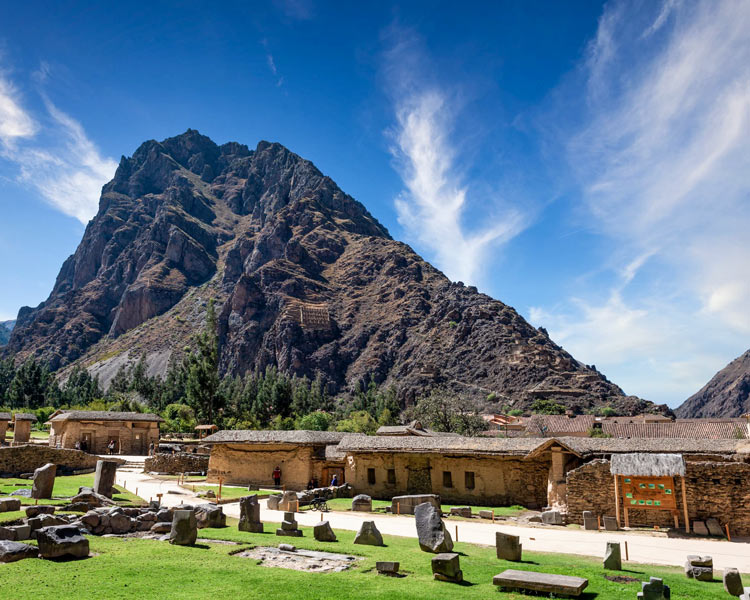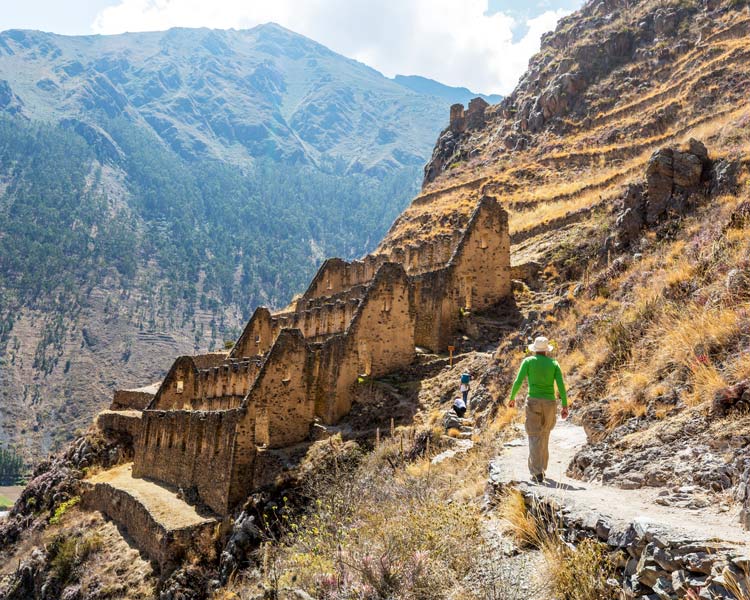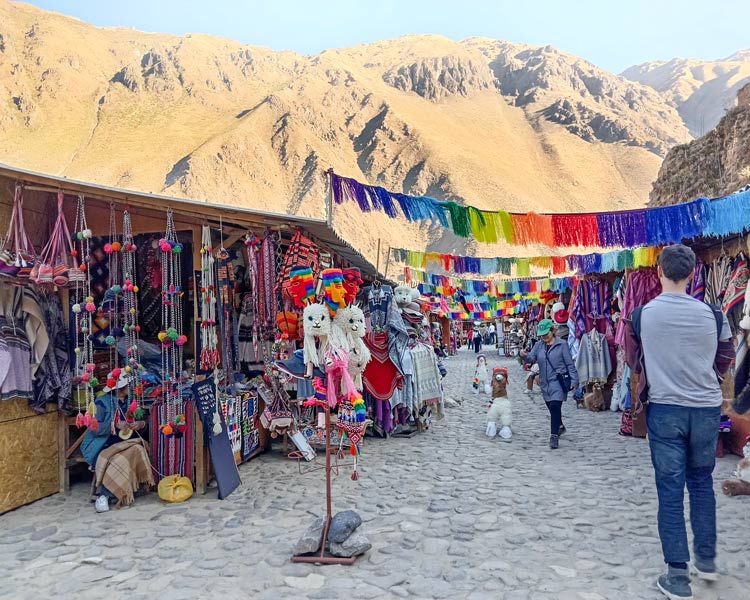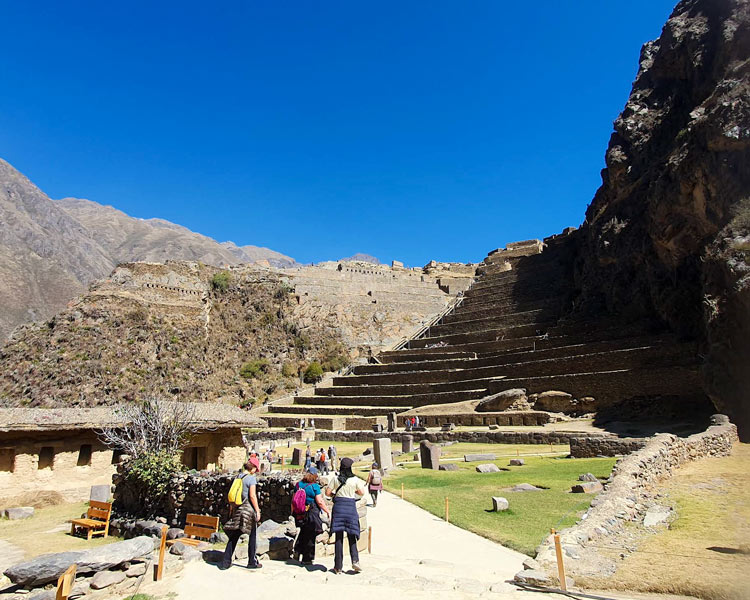Ollantaytambo, a jewel of the Sacred Valley of the Incas, is a must-see destination for those seeking history, culture and nature. It is not only a passing point to get to Machu Picchu, but it is a place full of culture and historical sites that frame the greatness of the Inca Empire, embark to know them.
Content
Planning your adventure in Ollantaytambo

Once you arrive in Ollantaytambo, the first thing you will find is a charming Inca village that transports you back in time. The narrow cobblestone streets create an atmosphere full of history and tradition. Here travelers and locals mingle, and every corner invites you to stop and admire the ancient architecture. According to your trip planning you can choose from the following:
- Transportation: Ollantaytambo can be reached by bus, car or train from Cusco. The most popular option is by bus, especially for those who continue the journey to Machu Picchu. There are also private and collective transportation services that allow greater flexibility in schedules and intermediate stops.
- Hospices: There are a variety of options, from hotels to Airbnb residences. Some accommodations offer immersive experiences, such as traditional home stays or eco-lodges. Booking in advance is recommended, especially in peak seasons such as June and July.
- Climate and clothing: Depending on the time of year, it is advisable to bring light clothing for the day and warm clothes for the night, as well as comfortable shoes to walk through the archaeological complexes and cobblestone streets. Don’t forget sunscreen, a hat and a waterproof jacket during the rainy season (November to March). For longer hikes, such as to Inti Punku, it is advisable to bring water and some snacks.
- Tickets and schedules: The entrance to the Ollantaytambo Fortress is included in the Cusco Tourist Ticket, which also gives access to other archaeological sites in the Sacred Valley. It is advisable to check updated schedules and prices before the trip..
Ollantaytambo Fortress Experience

The Ollantaytambo Fortress is much more than an archaeological complex, it is a living testimony of Inca engineering and culture. Located in a strategic position overlooking the town, this majestic construction was fundamental in both military defense and ceremonial life. Every corner tells a story of effort and ancestral wisdom.
Tour of the Fortress: The Most Important Points
- The ascent to the agricultural terraces: The climb is steep, but offers spectacular views of the Sacred Valley. These terraces served not only for crop production, but also as a defense against invaders.
- The Temple of the Sun: At the top of the fortress, this temple is composed of huge stone blocks. Its alignment suggests that it had an astronomical and ceremonial function.
- The Ñusta Baths: An impressive Inca hydraulic system, where water continues to flow through precisely carved stone channels..
- View of the warehouses in Pinkuylluna: From the fortress you can see the storage structures on the opposite hillside, used by the Incas to preserve food.
- Cyclopean walls: The precision with which large stones are fitted together remains a mystery of Inca engineering..
Note:
Remember that you can book the complete experience through our website, allowing you not only to know the Ollantaytambo Fortress, but all the adventures that Cusco has prepared for you. Don’t miss the opportunity to have the most memorable trip of your life!.
Characteristics of Ollantaytambo
| Features | Description |
|---|---|
| Location | Department of Cusco, province of Urubamba, in the Sacred Valley of the Incas. It is located 60 km from the city of Cusco. |
| Altitude | Approximately 2,792 meters above sea level. |
| Geography | Surrounded by mountains and located at the confluence of the Patakancha and Urubamba rivers. |
| Weather | Temperate and dry, with sunny days and cool nights. The rainy season runs from November to March, while the dry season, from April to October, is ideal for visits. |
| Average temperature | Between 10 °C and 22 °C, with lower temperatures during the night. |
| Population | Approximately 11 thousand inhabitants. |
| Historical importance | It was an Inca military, religious and agricultural center.. |
| Architecture | Cobblestone streets of Inca design, agricultural terraces, temples, water canals and colonial buildings on Inca foundations. |
What places to visit during my visit to Ollantaytambo?

In addition to the Ollantaytambo Fortress, there are other fascinating places to explore.:
- Pinkuylluna: A group of Inca warehouses located on a mountain in front of the Ollantaytambo fortress. The hike takes approximately 30 minutes and offers panoramic views of the town. It is believed that these warehouses were used to store grains and other agricultural products.
- Inti Punku (Sun Gate): This hike of approximately 4 hours leads to an imposing Inca gate from where you can see the snow-capped Veronica. It is a less visited site, ideal for those seeking a quieter experience in contact with nature. It is said that this place had a ceremonial and astronomical observation function.
- Cachicata Quarries: About 3 hours walk from Ollantaytambo, this site is key to understanding how the Incas transported and carved huge blocks of stone. Here you can see stones carved halfway through the process, which gives an idea of the hard work of the Inca builders.
- Ñaupa Iglesia: An enigmatic archaeological site with a carved stone structure and a ceremonial altar. Located in a cave, this place is considered an energetic portal and is associated with spiritual and astronomical practices. The precision of its cuts in the rock and its location make it a mystical and fascinating destination.
- Main Square of Ollantaytambo: A central point where you can appreciate colonial constructions on Inca foundations, as well as enjoy the local life. It is an excellent place to relax, buy handicrafts and taste the local gastronomy.
- Streets of Ollantaytambo: Walking the cobblestone streets of this ancient town is an experience that immerses you in the daily life and rich history of the region. The narrow avenues, charming handicraft stores and cozy traditional restaurants invite you to get lost and discover corners full of beauty and traditions.
Recommendations
- Research about the destination, knowing the history and significance of the places you will visit will enrich your experience.
- Purchase the Tourist Ticket in advance, this will facilitate access to the Fortress and other archaeological sites in the Sacred Valley.
- Book accommodation well in advance, especially in high season, as the best accommodations fill up fast.
- If you are short on time, prioritize the most important places and adjust schedules to avoid crowds.
- Wake up early to explore at leisure as the Ollantaytambo Fortress and other archaeological sites can get crowded with tourists after midday.
- Wear comfortable shoes: Many hikes include rugged terrain and unevenness, so it is important to have good grip.
- Hydrate yourself and bring snacks on long hikes, such as to Inti Punku or the Cachicata Quarries, it is essential to bring plenty of water and something light to eat.
- Wear sunscreen, sunglasses and a hat, especially in the dry season.
- Carry cash, many businesses in Ollantaytambo do not accept credit or debit cards.
- Respect the heritage, do not touch or lean on archaeological structures and follow the marked trails.
- Support local commerce by buying handicrafts, handmade products or taste the typical local gastronomy.
- Consider staying longer if you have flexibility in your itinerary, Ollantaytambo offers many experiences beyond a quick tour.
Frequently Asked Questions
-
How to get to Ollantaytambo from Cusco?
Ollantaytambo can be reached in several ways:
- By bus or colectivo: From the Pavitos bus stop in Cusco, buses take approximately 1 hour and 45 minutes..
- By cab: It is a faster and more convenient option, but also more expensive..
- By train: You can take a train from Poroy or San Pedro station in Cusco. This option is ideal if you plan to continue to Machu Picchu..
-
What is the best time to visit Ollantaytambo?
The best time is during the dry season (April to October), when there is less rainfall and the weather is ideal for exploring the archaeological sites. However, in the rainy season (November to March) the landscape is greener and with fewer tourists, although some roads can be slippery.
-
How much time is recommended to visit Ollantaytambo?
At least one full day is recommended to tour the fortress and explore the town. If you wish to hike to sites such as Inti Punku, Pinkuylluna or Ñaupa Iglesia, the ideal is to stay one or two nights.
-
How much is the entrance fee to the Ollantaytambo Fortress?
Access is included in the Cusco Tourist Ticket, which also gives entrance to other archaeological sites in the Sacred Valley. There is also the option of buying a partial ticket for the Sacred Valley only.
-
Do I need a guide to visit Ollantaytambo?
It is not mandatory, but it is highly recommended to have a guide to understand the history and architectural details of the fortress and other archaeological sites.
-
What other activities can be done in Ollantaytambo besides the fortress?
Some interesting options include:
- Hike to Pinkuylluna, the ancient Inca storehouses.
- Hike to Inti Punku (Sun Gate).
- Visit Ñaupa Iglesia, a mystical archaeological site.
- Explore the Plaza de Armas and the Inca streets of the town.
- Visit the Cachicata Quarries to learn how the Inca temples were built.
-
Is it safe to travel to Ollantaytambo?
Yes, Ollantaytambo is a safe destination for tourists. However, it is advisable to take basic precautions such as avoiding walking alone on remote trails at night and taking care of your belongings in crowded places.
